Vol 5 No. 43 TROPIC LIGHTNING NEWS November 9, 1970
Index
| Unit Page | Unit Page | Unit Page | Unit Page |
| 1/27 6 | 2/12 6 | 2/22 8 | 65th Engr. 4 |
| 1/27 7 | 2/12 8 | 2/22 Photo 8 | 65th Engr. 8 |
| 1/27 8 | 2/12 Photo 8 | 2/27 1 | 7/11 3 |
| 1/5 1 | 2/14 6 | 3/22 1 | 7/11 6 |
| 1/5 3 | 2/22 6 | 65th Engr Photo 4 |
Commanders Term
Combined Operation Successful
Thais, ARVN, Americans Flush Out the Enemy
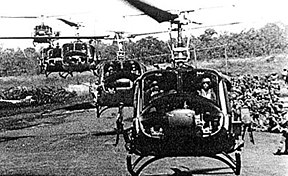 XUAN LOC - Two allied armies and the 2nd Brigade over a fifteen day period,
combined forces here to kill 43 enemy and and NVA battalion commander.
XUAN LOC - Two allied armies and the 2nd Brigade over a fifteen day period,
combined forces here to kill 43 enemy and and NVA battalion commander.
The 18th ARVN Division, three ARVN Ranger Battalions, the 1st and 2nd
Battalions of the Royal Thai Volunteer Army's 2nd Brigade had joined with Tropic
Lightning’s 2nd Brigade to force an NVA battalion out in the open.
Three ARVN Ranger Battalions were inserted into the center of the Allied
surrounded zone to "stir things up."
As a result, the 2nd of the 33rd ARVN Ranger battalion on the morning of the
eighth day 9 klicks northwest of Fire Support Base (FSB) Sqartz spotted five enemy and
engaged them with small arms fire. The engagement lasted about one minute, but on a sweep
of the area one enemy KIA was located with papers to indicate that he had been a battalion
commander.
Just six days later, the 2nd Battalion, 2nd Brigade, Royal Thai Army 15 miles
southwest of Xuan Loc engaged an estimated battalion size force for two hours. An initial
sweep of the area uncovered 25 enemy killed. A more detailed search in the double canopy
jungle revealed 14 more enemy dead for a total of 39 enemy killed.
In other action, Charlie Company and the Reconnaissance Platoon of 3rd
Battalion, 22nd Infantry Regulars accounted for seven enemy killed over a five day period
during the operation.
Charlie Company saw first action seven klicks northwest of Operation Base
(OB) Lynch where they engaged five enemy, killing two and capturing one detainee. One AK
47 rifle was evacuated along with 210 pounds of ammo.
Reconnaissance platoon followed with an early morning engagement of ten enemy
with their rifleman, a Light Fire Team and artillery killing two in the heavy jungles
seven klicks southwest of Fire Support Base Sqartz
Delta Company, later the same morning, detonated a claymore mine killing two
enemy. Two rucksacks and miscellaneous clothing were evacuated .
Charlie Company Regulars wound up the tally for US units by engaging three
enemy with organic weapons 14 klicks northeast of OB Lynch resulting in one enemy killed
and no US casualties.
ALL TOGETHER NOW, LAND – (Photo, above right)
Choppers drop into staging area for allied combined operation. Thais, ARVN and
Americans wait at left to board. (Photo by SP4 Todd Weber)
Charlie Sets a Fire;
Bobcats Get Charlie
By SP4 JOHN CORBIN
BEARCAT - A bunker complex and two dead enemy were netted by combined
elements of a 25th Division mechanized battalion and a local Regional Forces (RF) unit
recently on operations southwest of here.
The two-day search mission teamed the 1st Battalion (Mech). 5th Infantry's
Alpha Company and the 283rd Regional Forces of Long Thanh Province.
Through Jungle
The Bobcats and RFs were chopping their way through some very thick
jungle when one Gl noticed some smoking bushes.
"I pushed aside the bush and there was a smoldering fire-place made of
logs," said Specialist 4 Forrest Killian, of Washington, Ind .
The allies quickly posted security and carefully searched the area.
Six well-used bunkers built into the side of a hill were uncovered. Inside
were found 200 pounds of rice, cooking utensils, water cans and a bamboo flashlight. There
was also a note which was translated as a shopping list for a local store.
"We were obviously only minutes behind Charlie," said Specialist 4
Patrick Harding, of Portland, Ore. "We could still smell the nuc mam sauce in the
air."
Bunkers Destroyed
Before moving on, the bunkers were destroyed with demolition charges.
The next night, about two miles away, the Allies spotted the enemy himself.
"We saw a small group of VC coming down the trail towards our
position," said Sergeant Enberto Martinez, of Long Beach, Calif. "Everyone
alerted and then we popped them with small arms, machine guns and a few grenades."
Once contact was broken
Bobcat 81mm mortars illuminated the sky, enabling the men to sweep the
contact area. The sweep revealed the bodies of two VC and their field packs and
rifles.
WAIST DEEP - Members of a recon platoon with the 1st Battalion, 27th Infantry take the wet way during a recent operation. (Photo by SGT Dan Davis)
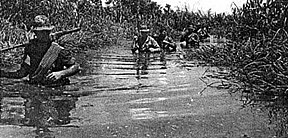 Squad of Seven Eliminated
Squad of Seven Eliminated
Wolfhounds Ambush VC Unit
By SGT JACK STRICKLAND
Cu Chi - A seven-man enemy squad was annihilated recently by 25th Division
Wolfhounds of the 2nd Battalion 27th Infantry, near here.
The operation began when Alfa Company was inserted by helicopter into an area
of recent Communist activity. Moving just inside a woodline to a suspected enemy supply
trail, the Hounds set out mechanical ambushes. Then they moved off to cover another area.
"We were coming up the trail when we saw some clothes lying in a
heap," said Private First Class Ted Misuraca, of Rockford, Ill. "We stopped and
surveyed the area, spotting; two VC."
The enemy tried to evade the Wolfhounds, but a quick barrage of M-16 fire
nailed one and winged the other. Following in hot pursuit of the wounded man, the Hounds
caught up at their mechanical ambush site.
There they found the bleeding survivor and five of his comrades who had
perished the night before, victims of the mechanical 'bush.
Besides the enemy personnel, the Wolfhounds discovered two AK47 rifles,
several full magazines, 264 pounds of rice, 15 rice bowls several bags of sugar and salt,
24 pairs of pants and 13 fatigue shirts.
Page 2 TROPIC LIGHTNING NEWS November 9, 1970
Treatment Not Punishment
Amnesty – The Safe Way Back
As if a troop didn't have enough problems with the three B's (bullets,
broads and black market), the fourth B, barbituates and other drugs, will give him more
trouble than the other three combined.
A lot of drugs are easily obtainable in-country and today's young GI is
curious about the effects and is willing to experiment. When he does, he sometimes finds
himself hopelessly dependent upon those drugs.
Amnesty Program
The Army has an amnesty program to help men who want to quit the drug
habit. To take advantage of the program which gives treatment and not punishment, a
soldier cannot have drugs in his possession nor have a narcotics charge pending against
him.
Take the guy who needs the program to the company commander, chaplain or
surgeon. They will get him into the right channels. The Army deals harshly with drug
users. A user can get up to five years at hard labor and a dishonorable discharge.
Security Risk
Think about it. A GI on the perimeter or on a guard post who is
experiencing space and time distortion from use of marijuana puts you and your unit at a
serious disadvantage. The security you expect him to provide is non-existant.
Below are listed five categories of drugs. It tells what they are, what
they’re called, what they do to a user and the dangers involved. Check it out:
MARIJUANA
Commonly known as "Pot, tea, grass, weed, Mary Jane." It affects
your sense of time and frequent users have lapses of memory. A person finds it hard to
make decisions. The user thinks he is ridding himself of problems; however he is adding to
them. None of his anxieties and tensions have been relieved and it leads to deeper and
more serious frustrations.
HEROIN
Commonly known as Horse, H, Smack. A man becomes warm and peaceful after
shooting. He becomes proud of himself and more confident. When the user gets
"hooked" his bode requires repeated and larger doses.
AMPHETAMINES
Commonly known as "Pep Pills." Makes the individual more confident
and supposedly more aware of their surroundings. Produces a sense of well being. Heavier
doses cause jitteriness, irritability, unclear speed and tension. The body runs down when
a person is "up" and the user is susceptible to diseases. There is no physical
dependency on the amphetamine but severe depression is the most danger to the person. He
gets suicidal depression.
LSD
Commonly know as "Acid." Brings on hallucination. Reality perishes
and the "tripper" is presented with varieties of colors and vibrations storm
through his head. The unpredictable state of this drug causes it to be dangerous. It can
cause: (1) panic – The user cannot stop the drug reaction; (2) paranoia – He
becomes suspicious, feeling someone is trying to harm him; (3) recurrence – any time
after the individual has quit using LSD, the things he saw or felt while on a trip may
recur; (4) accidental death – caused by feelings the users have, such as they can
fly, so they jump out a window.
Decorated
| BRONZE STAR | |
| Cpt James V. Hargis, Co C, 2d Bn, 27th Inf CPT Russell J. Houck, Co D, 4th Bn, 9th Inf CPT Reid C. Pickett, Co C, 4th Bn, 9th Inf CPT Paul A. Rohde, Co B, 1st Bn, 5th Inf CPT Sammie D. Sinimons, Co B, 4th Bn, 9th Inf 1LT George A. Gauthier HHC, i st Bn, 5th Inf 1LT Charles M. McNulty, Co E, 2d Bn, 3d Inf 1LT Richard Simmons, Co E, 3d Bn, 22d Inf 1LT Charles B. White, Co A, 4th Bn, 9th Inf 1LT William Yonushonis, Co B, 4th Bn, 9th Inf SSG Richard K. Brenner, F Co, 75th Inf SSG Jeseph E. Howell, Co C, 2d Bn, 22d Inf SSG Danny Justice, Co B, 4th Bn, 9th Inf SGT Chrles W. Clarke, Co E, 2d Bn, 3d Inf SGT Carvel M. Cook, Co C, 4th Bn, 23d Inf SGT William Fanguy, Co E, 2d Bn, 1 2th Inf SGT Gary W. Fernandes, Co D, 4th Bn, 9th Inf SGT James R. Hall, Co E, 2d Bn, 3d Inf SGT Marshal B. Klock, Co A, 4th Bn, 9th Inf |
SGT Danny B. Owens, Co E, 3d Bn, 22d Inf SGT Felix L. Ugale, Co C, 4th Bn, 23d Inf SP4 Elmer M. Bryant, HHC, 1st Bn, 5th Inf SP4 Raymond H. Hartness, Co A 4th Bn, 9th Inf SP4 Edward T. Johnson, Co D, 4th Bn, 9th Inf SP4 James F. Modlin, Co D, 4th Bn, 9th Inf SP4 Edward Oliver, Co E, 2d Bn, 12th Inf SP4 Wendell G. Setters, Co E, 2d Bn, 12th Inf PFC David A. Benton, Co A, 4th Bn, 9th Inf PFC Ronald M. Forche, Co A, 4th Bn, 9th Inf PFC Charles R. Griffin, Co D, 1st Bn, 5th Inf PFC George E. Harrison, Co D. 4th Bn, 9th Inf PFC Frank.Jacob, Co D, 4th Bn, 9th Inf PFC Michael P. Johnson, Co A, 4th Bn, 9th Inf PFC Kenneth J. Laperna, Co C, 1st Bn, 5th Inf PFC Steven J. Malosh, Co A, 4th Bn, 9th Inf PFC Errmal W. Richardson, Co C, 1st Bn, 5th Inf PFC Dale J. Sansegraw, Co C, 1st Bn, 5th Inf PFC Harold D. Wilson, Co A, 4th Bn, 9th Inf |
The TROPIC LIGHTNING NEWS is an authorized publication of the 25th Infantry Division. It is published weekly for all division units in the Republic of Vietnam by the Information Office, 25th Infantry Division, APO San Francisco 96225. American Forces Press Service and Army News Feature materials are used. Views and opinions expressed are not necessarily those of the Department of the Army. Printed in Tokyo, Japan, by Pacific Stars and Stripes.
MG Edward Bautz, Jr . . . . . Commanding General
MAJ Robert E. Kelso . . . . Information Officer
1LT Martin E. Webb . . . . . Officer-in-Charge
SP4 William M. Lane . . . . . Editor
SP4 Scott Watson . . . . . . . Assistant Editor
SP4 Michael J. Winston . . Production Supervisor
BATTALION CORRESPONDENTS
| SGT Derr Steadman SGT Mike Bailey SGT Bryon Fites SGT Mark Rockney SGT Mike Conroy SGT Daniel House SGT Jack Strickland SGT Dan Davis SGT Bob Lodi SP5 Tom Watson SP5 Doug Sainsbury SP4 Frank Salerno SP4 Tom Benn SP4 Greg Duncan |
Discom 4/23 4/23 2/12 3/4 Cav 4/9 1/27 1/27 1/5 725th 2/77 2/22 7/11 2/27 |
SP4 John Corbin SP4 Rich Erickson SP4 Ed Toulouse SP4 William McGown SP4 James Duran SP4 Kris Peterson SP4 Frank Morris SP4 Phillip Maslin PFC Dan Lowry PFC James Stoup PFC Doc Polis PFC Dan Danley PFC Mike Roberts PFC Richard Haley |
1/5 2/14 2/12 Divarty 3/13 3/22 2/34 2/27 2/27 65th Eng 269th 4/23 4/23 1/8 |
Tropic Lightning Tots
The Commanding General Welcomes
The Following Tropic Lightning Tots
To The 25th Infantry Division – As
Reported By The American Red Cross.
Born To:
| Oct. 7 SP4 Richard J. Lang, 187th Avn. Co., boy SP4 William Morehead, C Btry, 2nd Bn, 32 Arty, girl Oct. 9 PFC Michael Thomas, HHC 65th Eng, Boy SFC Ben Murry, C Co 125th Signal Bn, boy Oct. 10 SP5 Hugh West, B Trp 3/4., boy |
Oct. 14 SSG Frankie Catler, A Btry 2/27 Arty, girl SP4 Rick Baker, Co B 2nd Bn 14th Inf., girl Oct. 20 PFC Randy L. Sedelneier, 25th Admin Co., girl SFC Howard Abendorth, HH Btry 2nd Bn 77th Arty, boy Oct. 21 SP5 Harold Many, B Co 1/5th Inf, boy |
Page 3 TROPIC LIGHTNING NEWS November 9, 1970
LEVELING UP - (Below, right)
SP4 Robert Ramos of Modesto, Calif., uses a flashlight to see the leveling bubbles on his
81mm mortar tube. (Photo by SP4 John Corbin)
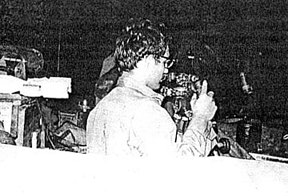 When Time is Tight
When Time is Tight
Bobcats Deliver in a Hurry
By SP4 JOHN CORBIN
BEARCAT - "Fire mission! Get on the guns," yells Platoon
Sergeant Elwood Dixon of Fallentimber, Pa. Immediately, the men of the weapons
platoon, Alfa Company, 1st Battalion (Mech), 5th Infantry run to their 81mm mortars.
The squad leader of the second squad, Sergeant James Schryer of Milwaukee
sits in his gun track by the radio waiting for the data from the fire direction center
(FDC) track.
In a few seconds, the required information comes from Sergeant Larry Rohling.
"Deflection 5802, 10 rounds HE (high explosive), charge four, elevation
1271. Give me a readback."
The squad leader repeats the information then relays it to his gunner.
The gunner, Specialist 4 Gary McCain of Elyria, Ohio begins spinning the base
plate to put the data on the tube. His head bobs up and down systematically, looking
through the site at the aiming stakes and checking the leveling bubbles.
In a few seconds the stovepipe had been juggled into the correct position.
"Up," yells the gunner
During all this, Specialist 4 Halie Caldwell of St. Louis and Private First
Class Calvin Hornick of Cudahay, Wis., the ammo bearers, have been (missing …)
81mm round, so five charges must be removed to make a charge of four.
The rounds are handed to the gunner as they are readied. Everyone places
their hands to their ears.
"Stand by," someone shouts. Then comes the "whop" of the
round hitting the firing pin. In jig time, ten rounds are on their way to the target.
The end of the mission is announced over the horn and Schryer and his men sit
back and take a break.
IT'S HAPPENING
SEND YOUR VOICE HOME FOR CHRISTMAS - If you
happen by the Service Club any day between the hours of 1 p.m. and 4 p.m., you will have
the opportunity to record a message for your home town radio station. Specialist 4 Bill
Baily and Specialist 5 Steve Kroft of the division information office will be there with
their tape recorders to capture a Christmas greeting from you. Then they'll dispatch the
tape to a station near your home for play during the holiday season.
TIME IS RUNNING OUT -- That $675 in Savings Bonds
being awarded to soldiers who enter the USARPAC re-up poster contest is still up for
grabs. Make your entries on plain white paper or poster board not less than 8 by 10 1/2
inches. Posters my be in black and white or not more than three colors. You don't have to
be a great artist to enter. All USARPAC is looking for is original, creative ideas. Mail
your entries to: USARPAC Poster Contest, APO 96558. The contest ends on November 30.
YOUR TYPE OF CLASS - The Cu Chi Education Center is
offering continuous typing classes to anyone wishing to learn from scratch or merely to
increase his speed and accuracy at the keyboard. The classes are conducted every Monday
and Thursday evenings from 6:30 p.m. to 8 p.m. No, you don't have to register. For further
information, call extension 5143.
PORT ASIDE...Gripin, an inalienable right of every
GI, does not apply just to soldiers of the American army. While operating a few miles west
of Dau Tieng recently, members of the Aero Rifles recon platoon of Delta Troop, 3/4 Cav,
found a note affixed to a tree. They asked their Vietnamese interpreter to let them in on
the little NVA secret. Translation: "Haiphong Sucks."
BEDTIME STORY - Pnvate First Class Jesse Albritton
had just finished a hard day's shift as a mechanic with the 1st of the 8th at Operation
Base Lynch. He shuffled back to his bunker, took dead aim on his bed, and crashed. He
immediately uncrashed. "I had the feeling that something was around my neck,"
Albritton said. "I guess I got scared and jumped and that's when he bit me."
"He" was a snake." Albritton grabbed his M-16 and gave his slithering
friend a vertical butt stroke. Minutes later, the mechanic was being dusted off, and two
days later he was back performing his duties with Bravo Battery. We don't know if the
snake was dusted off or not.
Hawaiian Native Acts In Hollywood Movies
By SP4 KRIS PETERSEN
FSB LYNCH - If someone were to yell "Lights, camera, action" at
this operation base, no doubt Staff Sergeant Wilfred Aki of Haaula, Hawau would come
running.
Aki, a veteran of 19 years in the Army and four tours in Vietnam, is also a
veteran of two Hollywood movies.
"I got a part in the film version of James Michener's "Hawaii"
while I was part of the cadre of the 25th Division's jungle training school in Hawaii
" Aki said.
"They needed native Hawaiians for the picture. Because of my size (6'
4", 275 pounds), I was a natural for the part of the village chief."
Aki admitted that the motion picture industry was more demanding than he
thought before he took the part. "We spent a lot of hours on the set. I
remember one scene that we shot 11 times in one day. He also noted that the movie's
stars Julie Andrews and Charleton Heston are just "people."
Aki said that he enjoyed working with them because they "were always
friendly and helpful, even after a long day on the set."
Aki had a small part in an earlier motion picture in the late fifties.
"It was called 'Rampage' and starred Robert Mitchum," he said. "Mitchum
both directed and starred in it."
Aki's talents do not end with a modicum of acting ability. He has been
involved in music since his days in high school. During a tour in Germany, he headed a
group that appeared in officer's and enlisted men's clubs throughout Europe.
"The group I have now, called the 'Hawaiians,' is made up of several of
my cousins and myself," he said. "We play mostly around my home town and for
family get-togethers."
During his 1966 Vietnam tour, Aki was on the first R & R flight to
Hawaii. "I'll never forget it," he said. "The governor was there and I got
a kiss from Miss Hawaii."
When Big Brother is Watching
Charlie Changes His Mind
By 1LT Richard Harris
(Page was crimped, xerox copy was missing some of the text of this story…)
the Regiment: While fighting and suffering extreme hardship, at times you probably
think of your home and family so far away. When will you see or get news from them again?
Hope is dim because you may die before you can see your families again... Then why
hesitate? Rally to the Government of Vietnam so that your families don't have to worry
about you..."
Every week, hundreds of thousands of these and similar (Missing…) civil
affairs (S-5) section.
The S-5 team plys at least two missions a week in a specially equipped
helicopter, dropping leaflets and broadcasting tape-recorded messages over a 1000-watt
amplifier.
The messages are directed towards both civilian and military targets and
towards both general and specific audiences. Civilians are bombarded with health leaflets
(Missing…)
as specific as possible, mentioning the enemy unit's dedication and the names
of personnel in the unit.
A good example was a recent leaflet drop near a rubber plantation and was
directed at a VC women's mortar platoon. The leaflet had a picture of the 10-woman unit
taken last December and asked, "Where are your sisters now?" to the two still
alive.
| READY, AIM - A gun crew from Alfa Battery, 7th Battalion, 11th Artillery prepares for the command to fire. (Photo by SP4 Tom Benn) | 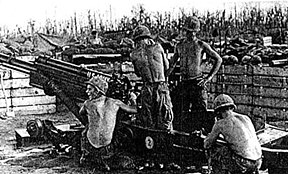 |
Page 4 - 5 TROPIC LIGHTNING NEWS November 9, 1970
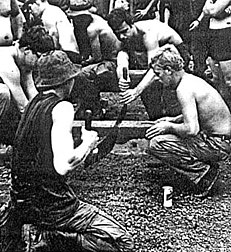 |
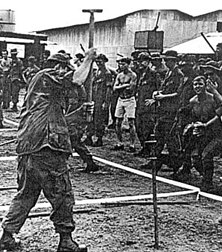 |
|
| SAWING -- During a Log Sawing contest, two
members of the 65th Engineer Battalion give it all they've got, at the 43rd Birthday
Celebration and Organization Day. (Photo by Joe Loper) |
HAMMER - Symbolic of the legend of Maxwell's Silver Hammer, this member of the 65th Engineer Battalion does his thing during a D-Handle Spike Driving Contest as the Engineers celebrate their 43rd Birthday and Organization Day. (Photo by Joe Loper) |
65th Enginees
Celebrate Anniversary With Sweat
By SP4 JAMES D. STOUP
CU CHI - From the impressive formation to the high spirited engineering
and sports competition to the good food and entertainment, the 65th Engineer Battalion
will long remember their 43rd birthday and Organization Day 1970.
Only a minor flood attempted to mar the days activities, but the engineers,
who you might say are used to the rain, remained undaunted and even seemed to enjoy
competing in the mud. The Battalion's Alpha and Bravo Companies were brought in from the
field to participate in and enjoy the day long stand down.
The day got underway for most with a Battalion formation and awards ceremony.
Guest of honor for the formation was the 25th Infantry Division Commander, Major General
Edward Bautz, lr., who reviewed the troops and presented the awards. Both he and the 65th
Engineer Battalion Commander, Lieutenant Colonel Forrest T. Gay III, made remarks about
the proud heritage and accomplishments of the 65th Engineer Battalion and lauded its
performance, both past and present.
Immediately following the formation the highly spirited sporting and
engineering competition between the companies began.
The monsoon rains fell most of the afternoon, and by the time the competition
was completed there was hardly a person who was not soaked from head to foot. The final
event of the competition, the tug of war, ended with a broken rope (a 3" thick rope
at that) and just about every company commander swimming in the specially prepared mud
hole.
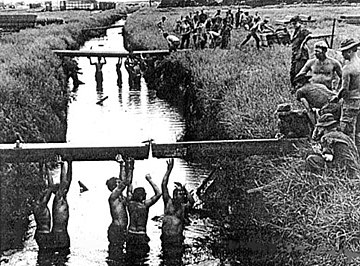 With the rain still falling and the troops still soaked, the
cookout prepared by company mess teams went into full swing (fortunately the food was
protected under a full canvas cover). There was plenty of good food and drink for all.
With the rain still falling and the troops still soaked, the
cookout prepared by company mess teams went into full swing (fortunately the food was
protected under a full canvas cover). There was plenty of good food and drink for all.
After a good meal, with the rains finally subsiding and the troops in dry
clothing, the engineers converged on the 65th Engineer EM Club for an evening of floor
show entertainment. Before the shows got underway, the Battalion Commander presented
trophies for the events of the days competition, with Alpha Company winning the overall
competition.
Organization Day 1970 will long be remembered by the 65th Engineer Battalion,
just as the 65th Engineer Battalion will long be remembered for its accomplishments in the
annals of the history of the United States Army.
CONSTRUCTION - (Above, right) Members of the
65th Engineer Battalion compete in constructing a 30 foot dry span bridge during their
celebration of the Battalion’s 43rd Birthday. (Photo by Joe Loper)
The results of the competition are as follows:
| VB | BB | 30'DS | AF | LC | LS | SD | PD | TW | Total | |
| HQ | 15 | 35 | 5 | 12 | 6 | 9 | 18 | 15 | 15 | 130 |
| A | 25 | 20 | 35 | 20 | 18 | 12 | 3 | 12 | 30 | 181 |
| B | 35 | 10 | 20 | 8 | 3 | 3 | 12 | 3 | 30 | 119 |
| C | 10 | 15 | 15 | 4 | 12 | 6 | 15 | 9 | 15 | 101 |
| D | 20 | 25 | 10 | 16 | 15 | 15 | 12 | 9 | 15 | 137 |
| E | 5 | 5 | 25 | 24 | 9 | 18 | 3 | 6 | 30 | 125 |
(Code for the above events is as follows): VB-Volleyball, BB-Basketball, 30'DS-30' Dry Span Bridge: AF-A Frame; LC-Log Chopping; LS-Log Sawing; SD-Spike Driving; PD-D Handle Picket Driving; TW-Tug of War. Alfa Company was overall competition winner.
Page 6 TROPIC LIGHTNING NEWS November 9, 1970
Reporter Asks, 'What's
It Like?'
Convoy Gunner-No Easy Job
By SGT DAN DAVIS
CU CHI - I approached one of the men in charge of escorting the convoy for
the 1st Battalion 27th Infantry, Wolfhounds between Dau Tieng and Fire Support
Base Kien, and asked him, "What’s it like?"
He answered with one question of his own: "Can you fire an M-60 machine
gun?" At a nod of my head, he said "Hop in," and grinned slyly.
The funny look on his face should have been a tip off, but I didn't catch it.
I was soon to find why there are actually very few people who have a genuine desire to
ride as a gunner on a 1/4 ton vehicle that is used for convoy escort.
Shortly thereafter we were headed out the gate leading a convoy of six or
eight other vehicles.
The road between Kien and Dau Tieng is quite different from the highways in
the states. It is full of holes that would pass for swimming pools back in the world. The
water buffalo and motorcycles try to compete with the convoy. This, in addition, to the to
the dusty debris covered road makes it obvious why the ride is so breathtaking.
Suddenly our vehicle hit the first hole in the road, and everything was
thrown upward and forward, including me.
In the same moment, everything that went up, came down. My steel pot, which I
hadn't noticed when it bounced off, came crashing down across the bridge of my nose, and I
noticed a lack of blood in my fingers which were wrapped very tightly around the M-60
machinegun's handles.
Each successive bump was like the first, until I started to get the knack of
wrapping one leg around the gun mount and wedging the other in between the wheel-well and
the ammo can on the bottom of the jeep. But even with this, by the end of the trip, you
feel as though your insides have been rearranged and that most of you is now located in
your feet.
The rest of the trip was for the most part uneventful. We were lucky
considering the number of times that these convoys have been ambushed, mortared and sniped
at by the enemy. Not to mention the accidents caused by poor visibility, and bad road
conditions.
Anyone need a job?
Artillery- Infantry
Work Along Together
By SP4 TOM BENN
FSB WARRIOR - Artillery and infantry are the king and queen of battle. Or
so recruits are told in basic training. But, it's not until they get to a combat zone,
that soldiers grasp the full meaning of the teamwork that is necessary between the two
branches.
Often fooling goes beyond more teamwork to mutual admiration. So it is at
Fire Support Base Warrior, located about eight miles northeast of Nui Ba Den.
Units from the 7th Battalion, 11th Artillery and 2nd Battalion, 12th Infantry
are unstinting in their praise for the other.
"I feel for them, " Private First Class David Hart from Charlie
Battery, 7/11 said of the infantry. "They really have it rough." "I
don't think Arty gets enough credit, but, then again, the grunts work harder and go
through more."
"We get along pretty good," said a 7/11 gunner. "They even eat
in our mess hall sometimes."
The praise doesn't go just one way. "We had Arty with us in
Cambodia," said Private First Class Dave Sheriff of Greenville, S.C., a rifleman with
Delta, 2/12. "It was really nice to have them around."
Cold Beer is No. 1
By SP4 GARY PETERSON
DAU TIENG - What is a cold beer?
As the weary grunts of the 2nd Battalion, 14th Infantry break out of the last
woodline before reaching this 25th Division base camp, a grimey machine gunner wipes his
brow and says to his buddy, "Wow, man, one more click to a cold beer."
To a Golden Dragon, a cold beer means that he can put his (Missing…)
about something besides where Charley may be waiting for him.
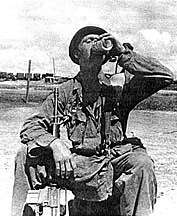 To many GI’s in the field, its not so much the taste of beer that they look forward
to as the mere thought of it. Many prefer soda, but sodas often come out to them on
resupply.
To many GI’s in the field, its not so much the taste of beer that they look forward
to as the mere thought of it. Many prefer soda, but sodas often come out to them on
resupply.
With a tall, cold one (beer) in his hand, however, a man knows that he's kept
himself together out there and has made it back to enjoy one of the base camp's rewards.
Cold beer you see doesn’t come out to the field.
God bless you Joseph Schlitz, Mr. Miller and Augie Busch; you’re the
grunt’s kind of people!
SMALL FROSTIE - Private First Class Leroy Gas of
Chicago, serving with Bravo Company, 2nd Battalion, 14th Infantry, takes a man sized gulp
of a cold beer after just returning from a long operation in the field. (Photo by SP4 Gary
Peterson)
Epidemic Spreading; Army Has
No Cure
By SP4 DENNIS LEBLANC
CU CHI - There appears to be a strange disease running rampant on a
world-wide scale It has no official name as yet; but is generally known as the
"Gap".
It is especially hard to isolate because it appears in so many differing
strains. The most persistent types are Generation, Credibility and Information Gap. The
latter type unfortunately, has appeared in the ranks of the 25th Division's 2nd Battalion
(Mech), 22nd Infantry.
Acting quickly, Triple Deuce made a preliminary survey of the men afflicted
with the disease and made some discoveries that enabled them to effectively cope with the
problem.
Strikes in the Field
First, the disease had a tendency to strike men in the field more often
than those working in the rear.
Hits Short GI's
Second, there were far more cases in men with 90 days or less to go
in-country. The newer men seemed to have some sort of natural immunity that wore off as
their days in-country increased .
Third, it seemed that there was a period of peak vulnerability. The disease
was more likely to be contracted just prior to an expected leave or R&R. There were
also an abnormally large number of cases just prior to DEROS dates.
Fourth it was learned after talking with the medics, that the conventional
pills and ointments were going to be of no help in treating this particular disease.
Now that the symptoms were clearly defined, a study was made of areas with
few, if any cases of Information Gap. With a few exceptions, it was found that these areas
had an information program which made extensive use of bulletin boards.
Bulletin boards in the rear areas were then conveniently placed and were kept
up to date with the latest information on leaves and R&Rs They also had information
about the unit and dates of upcoming events.
The subsequent success of the bulletin board program in curtailing
"Information Gap" has led Triple Deuce to believe that the program will work in
the field.
Page 7 TROPIC LIGHTNING NEWS November 9, 1970
Add New Meaning to Old
Word
Wolfhounds Train Vietnamese
By SGT DAN DAVIS
CU CHI - For the 25th Division's Bravo Company, 1st Battalion, 27th
Infantry and the members of the 170th Regional Forces, "Vietnamization" is more
than just a word. It has real meaning.
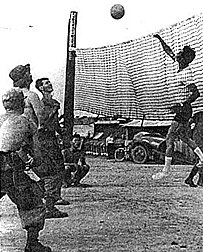 The men are engaged in a pilot program testing whether the average GI can, with a minimum
of special training, instruct Vietnamese soldiers and improve their methods of operation.
The men are engaged in a pilot program testing whether the average GI can, with a minimum
of special training, instruct Vietnamese soldiers and improve their methods of operation.
The program began recently at the 25th Division's Tropic Lightning Academy.
In this five-day course, the Americans were taught methods of instruction, use of
interpreters and Vietnamese customs.
As soon as they completed the course, the Wolfhounds used their newly
acquired skills to teach several local RF units.
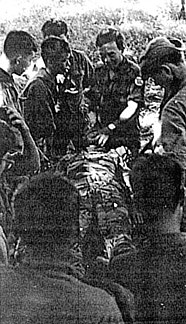 Some of the subjects covered were ambush techniques, field fortifications, weapons
maintenance, dustoff procedures and first aid.
Some of the subjects covered were ambush techniques, field fortifications, weapons
maintenance, dustoff procedures and first aid.
"Our basic problem of course, is communication," said 1st
Lieutenant Charles Dixon, of Washington, D.C., "because everything must be done
through an interpreter."
"The Vietnamese do catch on fast to the things we are teaching them. All
they needed was for someone to show them how and why things were done. That's all. They're
aggressive and eager to learn."
At the end of the instructional phase, the combined companies went on a
search and clear mission in the vicinity of a French-owned rubber plantation north of
here.
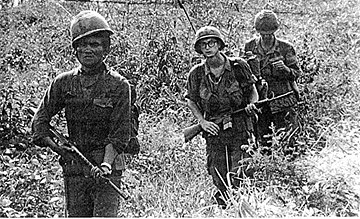 Using
one element as a blocking force and another as a sweep team, the Wolfhound-Tiger unit
employed their newly-learned skills. At one point a Vietnamese member of the sweep team
discovered a well-concealed enemy booby-trap.
Using
one element as a blocking force and another as a sweep team, the Wolfhound-Tiger unit
employed their newly-learned skills. At one point a Vietnamese member of the sweep team
discovered a well-concealed enemy booby-trap.
Sergeant Nguyen Van Than, a South Vietnamese interpreter for the Wolfhounds,
is encouraged by the program.
"The South Vietnamese people used to be afraid of the VC and NVA so they
helped them," he said. "Now that people can see the RF growing stronger, they
are openly opposing the Communists."
[PHOTO CAPTIONS: (Top, left) SPIKE - Regional Forces soldiers take on their advisors
in a game of volleyball during respite from instruction. (Top, right) FIRST AID - Sergeant Nguyen Van Than repeats, in
Vietnamese directions in first aid given by the Americans in English. (Bottom,
left) FINAL PHASE – Combined elements of
the 25th Division’s Bravo Company, 1st Battalion, 27th
Infantry and the Vietnamese 170th Regional Forces Company work together on an
operation near a French-owned rubber plantation. RF cadre were in charge of the operation;
Americans acted as coaches.
Page 8 TROPIC LIGHTNING NEWS November 9, 1970
In His Second Army
Czech
Serves Tour in 'Nam
By SGT ED TOULOUSE
DAU TIENG - In 1968, Miroslav Syrucek, pulling the greatest escape of his
life, slipped through the Iron Curtain to freedom.
Now, two years later and many miles away from his native Czechoslovakia, the
25th Division infantryman is in Vietnam helping to counter the oppression he grew up
under.
Born in Hradec Kralove, Mike (as he is called by his buddies) experienced the
inequities of Communism at an early age.
In 1952, his father, the proprietor of a gas station and motel, lost control
of his business to the Party. Six months later, the elder Syrucek, a non-party member, was
convicted of certain ill-defined crimes in connection with the use of Radio Free Europe.
Shortly after, he was killed - the victim of a freak prison "accident. "
Subsistence became the way of life for Mike's mother and her three children.
Jobs were hard to find in the politically oppressed country .
"Good jobs are usually only given to party members," said Syrucek.
"My mother took in boarders and did laundry to keep us going.
Graduating from a trade school at 18, Mike was soon drafted for a twenty-six
month tour as a sentry on the Czech-Austrian border.
It was during this time that Communist indoctrination reached a climax.
Obliged to attend daily party-oriented classes Syrucek underwent a concentrated barrage of
propaganda. As a member of the army he was compelled to sign a pledge to fight for the
Communist cause in Vietnam, if the need arose.
Party pressure kept increasing until one day in January, 1968, Syrucek was
informed that the time for him to sign up with the "people's party" had arrived.
"I wanted nothing to do with an organization that was responsible for my
father's death and my family's suffering "
Desperation provided the initiative. Taking advantage of the situation while
on guard duty, the young Czech opened the gate and made a running bid for freedom across a
seemingly endless limbo dividing Czechoslovakia and Austria.
"All I remember is running hard and praying as I went."
The deep snow and sub-zero temperatures made going difficult, but Syrucek's
determination prevailed. Within an hour Austrian officials were processing the happy
refugee.
Several months later, at about the same time Soviet tanks were rumbling
through his homeland during the famous Czech rebellion, Mike came to the United States.
With the help of a fellow countryman he became a machinist in South Paris, Maine.
"I really enjoyed the state. The people were very friendly and eager to
help me adjust and learn the language."
However, his stay in Maine was interrupted a year after his arrival when he
was drafted. Now Syrucek is a member of a point, element with the 1st Battalion, 27th
Infantry Wolfhounds. He has eight months left in this, his second army.
His future plans are well-defined. "Three and a half years ago I
was in uniform and today I still am. I've traveled a lot during this time-now all I want
to do is settle down somewhere, probably in Maine."
TOC Ties Together
By SP4 ED TOULOUSE
FSB WARRIOR - Battalion radio communication, the mainstay of the 25th
Division, is a hodgepodge of frequencies call signs and distortion which for most people,
would defy comprehension.
For a 2nd Battalion, 12th Infantry, RTO (radio telephone operator), a GI with
the matched skills of a New York City telephone operator, this conglomeration of words is
his "lingo."
The tactical operations center (TOC) is home base for battalion level
communications. Here the RTO works amid the relentless squawking of several radios.
"TOC can be pretty hectic at times," said Specialist 4 Dan Parsons,
of Litchfield, Maine. "But its all just a matter of getting accustomed to the sounds
and the pace."
During Warrior troop movements or enemy contact, the TOC radio operators work
in coordination with command & control helicopter personnel as they make a visual
reconnaissance of the area.
(Missing…) Captain Anthony Moreno, of Waipahu, Hawaii.
TOC is also the crossroads of a variety of communications traffic.
''We call for artillery, dustoffs, resupply, gunships and anything else
needed " said Specialist 4 Lawrence Jackson of Atco, N.J. "And just last week we
even made a call to the field telling one guy that his wife had a baby boy!"
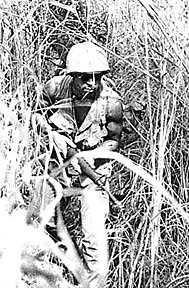 |
HIDE AND SEEK - The game played here is played by many but enjoyed by few. This man, a member of C Company, 2nd Battalion, 12th Infantry, is searching the two-way rifle range in search of the enemy. (Photo by SGT MARK ROCKNEY) |
The Triple Deuce Navy
River Patrol Checks Enemy
(There was a fold in the xerox copy of this page and parts of the story are
missing…) Communist might have seen was true. Recently, while on operations 19 miles
northeast of here, a 25th Division mechanized unit took to the water to patrol the Saigon
River on an armored personnel carrier (APC).
"The purpose of this (Missing…) Bravo Company commander of the 2nd
Battalion (Mech), 22nd Infantry, from San Rafael, Calif.
The men and their APC traveled up and down the river on a raft which was
provided by Echo Company, 65th Engineer Battalion. The raft was actually a pontoon bridge
propelled by several small motor boats.
(Missing…) guns and semiautomatic weapons.
There was. also a radar set aboard so that, if the men couldn't see the
enemy, the electronic device could at least detect their movement.
"It certainly was an unusual operation for a mech unit," said
Specialist 4 Jerry Smith, of Woodbndge, N.J. "Just call us the Triple Deuce
Navy!"
(Missing…)
$500 reward for whereabouts of Wayne Olson, 15 yrs, 5 ft. 6 in., blue eyes, blond curly
hair, phone Van., B.C. collect 731-6672.
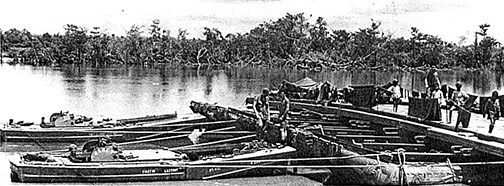 |
| PREVENTING ENEMY CROSSING - A pontoon bridge which was built by Echo Company, 65th Engineers, was used as a raft for an armored personnel carrier of Bravo Company, 2nd Battalion (Mech) 22nd Infantry. The carrier was driven on to the raft, and the boats pulled it up and down the Saigon River on a roving ambush patrol at night to prevent enemy crossing. |
Thanks to
Ron Leonard, 25th Aviation Bn., for locating and mailing this issue,
Kirk Ramsey, 2nd Bn., 14th Inf. for creating this page.
This page last modified 8-12-2004
©2004 25th Infantry Division Association. All rights reserved.